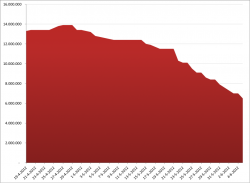Way, way back, on April 19, 2012, BranchOut impressed the online recruitment community with incredible growth numbers. CEO Rick Marini boasted 25 million people who signed up for his service and mentioned a growth rate of three new users signing up per second! No wonder he could also proudly mention another round of funding, a stunning $25 million, bringing the total to $49 million … all-around impressive.

However, the world of BranchOut looks completely different today, at least according to the data provided by AppData and Facebook. They present what is called the monthly average users number. And when we look at the development of this figure since the date of Marini’s moment of glory, we get this picture:
BranchOut peaked in the period of April 27-29 with a total MAU of 13.9 million. Today that number is just 6.5 million, a loss of a staggering 7.4 million MAU in just 37 days. That relates to a loss of 2.3 MAU per second! At this rate BranchOut will hit zero MAU in just over a month, or 33 days.
How is it possible that at one moment a site can grow so fast only to suddenly reverse course and plummet nearly as fast? There is a word for such an event: Ponzi. BranchOut is nothing but a Ponzi scheme. When you sign up for BranchOut, it is really, really easy to inadvertently send out BranchOut invitations to all your friends on Facebook (to a Facebook imposed maximum of 50). Not only that, you also allow BranchOut to repeat this process multiple times over. This is the reason for the large number of complaints of Facebook users regarding BranchOut spam.
More importantly, this tsunami of BranchOut invitations grew exponentially with each new user signing up for the service, up until the point that the whole of the Facebook community had received BranchOut invitations multiple times over. That is the moment that the growth engine of this classic Ponzi stops. Which happened somewhere during April, possibly even before Marini proudly presented his massive growth number.
Separate from the MAU number there is also the number of daily average users. And this tells us something about the actual usage of the service on a day-to-day basis. For BranchOut this number stood at 110,000 as of June 4, down from 650,000 just one month ago. The DAU has thus far fallen much sharper then the MAU, strongly indicating the rapid drying up of new registrants.
On any given day the DAU is a combination of the number of users signing up for BranchOut as well as returning users. If we conservatively assume that at least 50% of the DAU is made up out of new registrants, it also means that apart from this group nearly no one is actually using the service. How’s that?
Well, let’s do a simple experiment with the numbers. Assuming that 50% of the DAU are new registrants this means that over the course of the last 30 days some 6.5 million people have signed up for BranchOut. It also means that since Marini’s moment of fame on April 19 there will have been somewhere between 10 to 15 million new registrants, bringing the total of BranchOut registered users to a maximum of 40 million. A truly impressive number!
But the only number that tells us anything about the relevancy of the service is the number of users actually using it. And as of yesterday that number stands at 55,000. Or in other words, a whopping 0,14% of registered users. That’s massively lower than LinkedIn! And this incredibly low engagement figure would also immediately explain the head-scratching of pundits wondering where the value of BranchOut lies. And this number is may be much lower if we assume that the actual percentage of returning users within that DAU number is lower than 50%. Much lower.
BranchOut has peaked and is now returning back to earth at a neck-breaking pace. However, it is possibly not too late to start focusing on bringing actual value to registered users instead of focusing on media appearances. The $ 49 million in funding can be put to use to build something useful instead of daydreaming about an IPO and cashing in big. It requires real work, focus, and total user centricity. Then and only then is there a slim chance that BranchOut can become something of a LinkedIn challenger. Now it’s just a loudmouth brat with nothing to show for. There is still time to avoid the Deathpool, but time is running out fast.